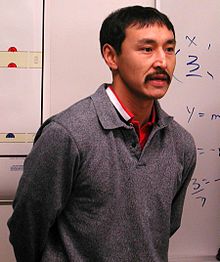Paul Okalik
|
Paul Okalik ᐹᓪ ᐅᑲᓕᖅ MLA |
|
|---|---|

Okalik in January 2001
|
|
| 6th Speaker of the Legislative Assembly | |
|
In office November 4, 2010 – April 6, 2011 |
|
| Preceded by | James Arreak |
| Succeeded by | Hunter Tootoo |
| 1st Premier of Nunavut | |
|
In office April 1, 1999 – November 19, 2008 |
|
| Prime Minister |
Jean Chrétien Paul Martin Stephen Harper |
| Commissioner |
Helen Mamayaok Maksagak Peter Irniq Ann Meekitjuk Hanson |
| Preceded by | Position established |
| Succeeded by | Eva Aariak |
| Member of the Legislative Assembly of Nunavut for Iqaluit-Sinaa | |
|
Assumed office October 28, 2013 |
|
| Preceded by | Riding Established |
| Member of the Legislative Assembly of Nunavut for Iqaluit West | |
|
In office February 15, 1999 – April 6, 2011 |
|
| Preceded by | Territory Established |
| Succeeded by | Monica Ell |
| Personal details | |
| Born |
May 26, 1964 Pangnirtung, Northwest Territories (now Nunavut), Canada |
| Political party | Liberal Party of Canada |
Paul Okalik, MLA (Inuktitut: ᐹᓪ ᐅᑲᓕᖅ, IPA: [paːl ukaliq]; born May 26, 1964) is a Canadian politician. He is the first Inuk member called to the Nunavut Bar, the first Premier of Nunavut and the only multi-term premier elected in consensus-style governments of Nunavut and the Northwest Territories.
On November 4, 2010, he was elected Speaker of the Legislative Assembly of Nunavut. Okalik represented the electoral district of Iqaluit West in the Legislative Assembly of Nunavut until April 6, 2011 when he announced he would be resigning in order to run for the Liberal Party of Canada in the riding of Nunavut in the 2011 Canadian federal election.
Okalik was born on May 26, 1964, in Pangnirtung, Northwest Territories (now Nunavut), the youngest of ten children born to Auyaluk and Annie Okalik. He was sent to residential school in Frobisher Bay, now Iqaluit, at 15, returning to Pangnirtung after one year. He began a series of temporary jobs and pursuits including time as an apprentice underground at the Nanisivik Mine in northern Baffin Island. In the early 1980s, he became interested in the political development of Inuit communities and began to work for the Tunngavik Federation of Nunavut, the predecessor of Nunavut Tunngavik Incorporated, as a deputy negotiator on the Inuit land claim, the Nunavut Land Claims Agreement. That claim, the largest in Canadian history, was signed in 1993 after decades of negotiations between Canada and the Inuit of Nunavut and would lead to the creation of Nunavut that he was to lead through its first decade.
...
Wikipedia
